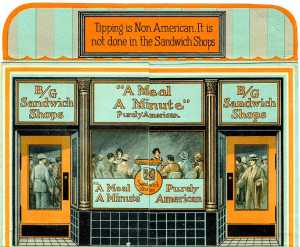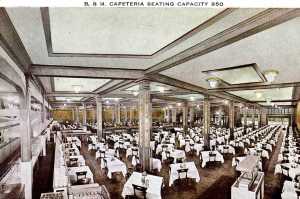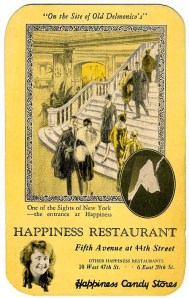 Anyone who knows American culture realizes immediately that the term “adult restaurant” would not even remotely imply an eating place that caters to mature or developed culinary tastes. Instead it would mean one deemed inappropriate for children because of some kind of sexually tinged goings on.
Anyone who knows American culture realizes immediately that the term “adult restaurant” would not even remotely imply an eating place that caters to mature or developed culinary tastes. Instead it would mean one deemed inappropriate for children because of some kind of sexually tinged goings on.
Historically the attractions in adult restaurants have not been what’s on the plate but are part of the female servers’ anatomy.
An unfamiliar restaurant concept to me is the “adult fast food restaurant.” This is how a Florida drive-in owner referred to his business in 1976. It didn’t serve adult fast food – what would that be? Crêpes? It served hot dogs, hamburgers, beer, and, oddly, wine. The manager called it “our answer to MacDonald’s,” reflecting the fierce competition drive-ins faced from big chains in the 1970s.
The “adult” aspect: servers at the “Jugs ‘n’ Suds” drive-in were costumed only in hot pants and tassles.
 However, Jugs ‘n’ Suds waitresses got very little chance to “wear” their intended costume. The drive-in met with vehement disapproval from citizens and officials of New Port Richey who insisted that the waitresses cover up. One of the restaurant’s promoters admitted that business fell off once apron-like halter tops were adopted, saying “People aren’t as interested in seeing a topless waitress with fringe on.” [pictured] In very short order the drive-in closed. A second one – without carhops — then opened in an old A&W. I don’t think it lasted long. A fantasized nationwide chain never materialized.
However, Jugs ‘n’ Suds waitresses got very little chance to “wear” their intended costume. The drive-in met with vehement disapproval from citizens and officials of New Port Richey who insisted that the waitresses cover up. One of the restaurant’s promoters admitted that business fell off once apron-like halter tops were adopted, saying “People aren’t as interested in seeing a topless waitress with fringe on.” [pictured] In very short order the drive-in closed. A second one – without carhops — then opened in an old A&W. I don’t think it lasted long. A fantasized nationwide chain never materialized.
Jugs ‘n’ Suds was unusual in that it was a drive-in. Most topless restaurants have been positioned at the “nightclub” end of the restaurant spectrum. Typically they’ve been dark, bar-like spaces where business men congregate at noon and after work.
California was the birthplace of the topless restaurant with the pioneers opening in 1965 not long after the creation of Rudi Gernrich’s topless bathing suit. Many offered a business man’s lunch special accompanied by models strolling from table to table. In California, at Long Beach’s Kozy Kitten, kittens ambled while patrons downed 98c luncheons of Turkey, Ham, or Beef served with Potato Salad and Beans. (I didn’t say topless restaurants were glamorous.)
The topless restaurant fad, which combined gawking, drinking, AND eating, died out, but using women’s anatomy to attract restaurant patrons did not. Maybe it’s eternal. Even as the last Playboy bunny club closed in the 1988, a new crop of “breastaurants” (as they are mockingly known by critics) appeared, most of them flaunting scantily dressed servers. Following the success of Hooters, a slew of knock-offs opened in Florida, among them the so preciously named Melons, Knockers, and Mugs & Jugs.
 Controversy is also eternal. Hooters’ aggressively suggestive advertising campaign has offended many and the chain was forced to remove billboards that hinted servers were prostitutes, an idea that, depressingly, has plagued female servers since the 19th century.
Controversy is also eternal. Hooters’ aggressively suggestive advertising campaign has offended many and the chain was forced to remove billboards that hinted servers were prostitutes, an idea that, depressingly, has plagued female servers since the 19th century.
Legal challenges to topless restaurants and breastaurants have mostly not held up. But communities protest them anyway, occasionally successfully. Recently the Quincy MA Licensing Board denied permission to a unit of the Tilted Kilt chain because it was too close to a church that objected.
© Jan Whitaker, 2012
 Judging from postcards and cartoons, the early 20th century was not a fun time to be a waitress. However hard working, competent, or skilled in dealing with demanding situations they may have been [see recent op-ed on how much skill serving takes], there was no recognition of that in popular images.
Judging from postcards and cartoons, the early 20th century was not a fun time to be a waitress. However hard working, competent, or skilled in dealing with demanding situations they may have been [see recent op-ed on how much skill serving takes], there was no recognition of that in popular images. The reasons for these degrading images could be many. Joke-style postcards were designed to get men to send postcards, an activity that they were less inclined to do than were women. Almost all joke postcards derived humor from insulting others, whether women, Blacks, immigrants, or the poor. On several of the cards in the post, the women illustrated are Irish immigrants, a status that was generally portrayed as both stupid and ugly. Women who were in the public eye, such as actresses, department store clerks, or restaurant workers, were evidently considered fair game, possibly out of resentment that they strayed outside the realm of church and home or because they appeared in public without male protection.
The reasons for these degrading images could be many. Joke-style postcards were designed to get men to send postcards, an activity that they were less inclined to do than were women. Almost all joke postcards derived humor from insulting others, whether women, Blacks, immigrants, or the poor. On several of the cards in the post, the women illustrated are Irish immigrants, a status that was generally portrayed as both stupid and ugly. Women who were in the public eye, such as actresses, department store clerks, or restaurant workers, were evidently considered fair game, possibly out of resentment that they strayed outside the realm of church and home or because they appeared in public without male protection. Later postcards mostly dropped the theme of incompetence but images of sexy bimbo waitresses persisted for decades, as for example on this postcard mailed in 1946.
Later postcards mostly dropped the theme of incompetence but images of sexy bimbo waitresses persisted for decades, as for example on this postcard mailed in 1946.
























 It's great to hear from readers and I take time to answer queries. I can't always find what you are looking for, but I do appreciate getting thank yous no matter what the outcome.
It's great to hear from readers and I take time to answer queries. I can't always find what you are looking for, but I do appreciate getting thank yous no matter what the outcome.


